The term history painting was introduced in the 17th century by the French Royal Academy. For many years after that it was considered the most important genre of painting above portraiture, still life, landscapes and other genres. Though initially dominated by religious and mythological works, the genre later expanded to include events from actual history. History painting may be further divided into five major sub-genres. These are religious, mythological, allegorical, literary and historical. In this article we focus on historical paintings which are defined as pictures depicting an event or a moment in history. The Battle of San Romano by Paolo Uccello, which was created in the 15th century, is the earliest painting on our list; while Pablo Picasso’s masterpiece Guernica, which was painted in the mid-20th century is the latest. Here are the 10 most famous historical paintings of all time.
#10 The Battle of San Romano
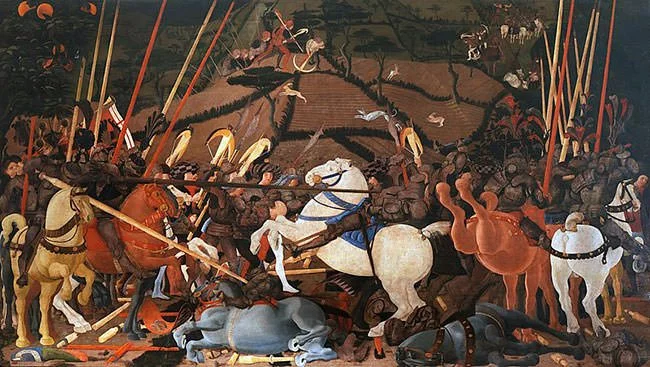
| Location: | National Gallery, London |
| Artist: | Paolo Uccello |
| Year: | 1460 |
San Romano is a town in Tuscany, central Italy, around 30 miles outside Florence. The Battle of San Romano was fought on June 1, 1432 between Florence, which was commanded by Niccolò da Tolentino; and Siena, which was led by Francesco Piccinino. The Florentine forces are generally considered to be victorious in the conflict. Florentine painter Paolo Uccello depicted the key events of this battle a set of three paintings titled The Battle of San Romano. They are his best known works and, among other things, they showcase the development of linear perspective in the early Renaissance period in Italy. The three paintings are now housed in different museums. Niccolò da Tolentino at the Battle of San Romano is at National Gallery, London; Niccolò da Tolentino unseats Bernardino della Carda is at Galleria degli Uffizi, Florence; and The Counterattack of Michelotto da Cotignola is at the Louvre, Paris.
#9 The Death of General Wolfe
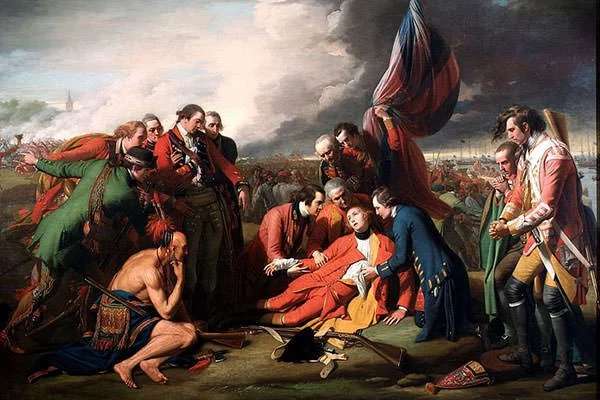
| Location: | National Gallery of Canada, Ottawa |
| Artist: | Benjamin West |
| Year: | 1770 |
Entirely self-taught, Benjamin West was a British North American artist who has created some of the best known historical paintings. The Battle of the Plains of Abraham, also known as the Battle of Quebec, was a pivotal battle in the French and Indian War between the colonies of British America against those of New France, area colonized by France in North America. Fought on September 13, 1759, the Battle of Quebec was a decisive success for the British forces but it came at the cost of General James Wolfe, who led the British American forces in the battle. This painting by Benjamin West commemorates the death of the General at the moment of victory. He depicts General Wolfe as a Christ-like figure and the painting contains vivid suggestions of martyrdom. Housed at the National Gallery of Canada, it is the most famous work by West and one of the best known historical paintings in English art.
#8 The Roll Call
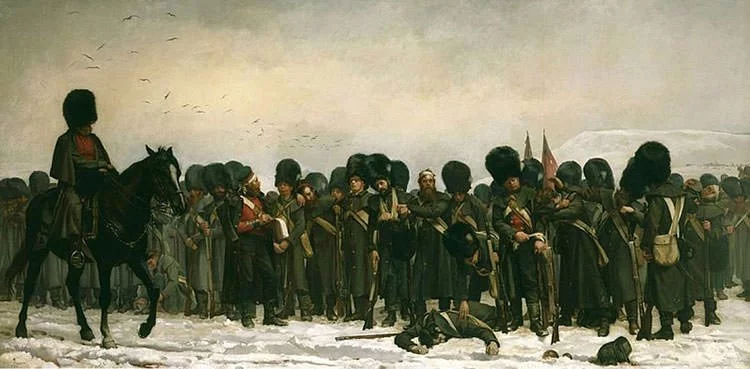
| Location: | Royal Collection of the British royal family |
| Artist: | Elizabeth Thompson |
| Year: | 1874 |
This painting depicts a roll call of soldiers of the Grenadier Guards, an infantry regiment of the British Army. This regiment is a renowned British regiment which has taken part in numerous wars. In this painting, Elizabeth Thomson depicts the roll call following the Battle of Inkerman in 1854, which took place in the Crimean War between Russia and an alliance made up of the Ottoman Empire, France, United Kingdom and Sardinia. The original title of the painting is Calling the Roll After An Engagement, Crimea; though it is more famous as The Roll Call. It shows an irregular line of private soldiers, who stand in the snow wearing their greatcoats and bearskins. Most of them are clearly exhausted or wounded. Thompson specialized in painting scenes from British military campaigns and battles. The Roll Call became not only her best known painting but also one of the most celebrated British paintings in the 19th century.
#7 The Death of Sardanapalus
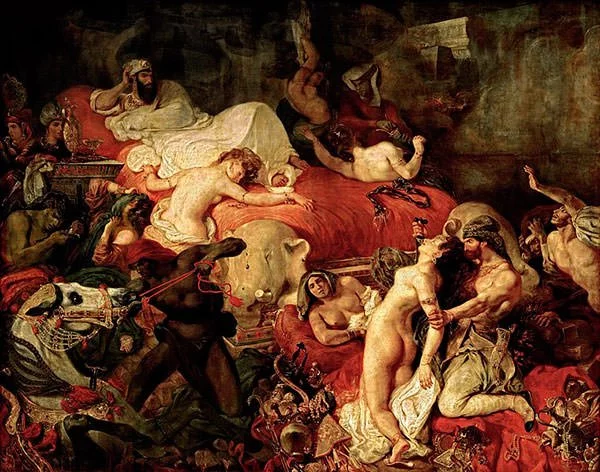
| Location: | The Louvre, Paris |
| Artist: | Eugène Delacroix |
| Year: | 1827 |
Eugene Delacroix was the leading artist of the French Romantic era of the 19th century and he is regarded as the greatest French painter of his time. Sardanapalus was the last king of Assyria according to the Greek writer Ctesias. It must be mentioned that this is not true and in fact, there is little resemblance of Sardanapalus to any known Assyrian king. Anyway, Sardanapalus is portrayed as a self-indulgent king who dies in an orgy of destruction. This portrayal of his death served as a theme in Romantic literature and art. One of the best known works on the subject as well as that of the artist, The Death of Sardanapalus depicts the king overseeing, with a disinterested eye, the destruction of all his possessions in a funerary pyre of gore and excess. Among other things, it portrays a number of women in various degree of undress struggling against death by the hands of the men in the picture. Apart from its rich colors and its broad brushstrokes, the painting is famous for being an early Romantic work which challenged neoclassical traditions.
#6 The Death of Marat
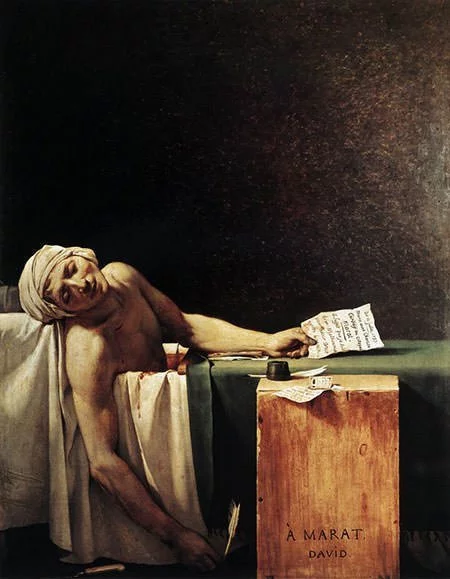
| Location: | Oldmasters Museum, Brussels, Belgium |
| Artist: | Jacques-Louis David |
| Year: | 1793 |
Jean-Paul Marat was a journalist and politician who was one of the most radical voices of the French Revolution. His paper, L’Ami du peuple (Friend of the People), was the most celebrated radical publication of the revolution but it was also considered reckless as it instigated violent and rebellious behavior. Charlotte Corday, who came from a minor aristocratic family, blamed Marat for the September Massacre during the Reign of Terror. She gained entrance to his room on the pretext that she had information of counter-revolutionary activities. Marat, who spend much time in his bathtub due to a skin condition, was fatally stabbed by Charlotte on 13th July 1793. She was later tried and executed. The Death of Marat, which shows the radical journalist lying dead in his bath, is one of the most famous pictures of the French Revolution. It is also the most famous work of Jacques-Louis David, the leading French painter of his era.
#5 Washington Crossing the Delaware
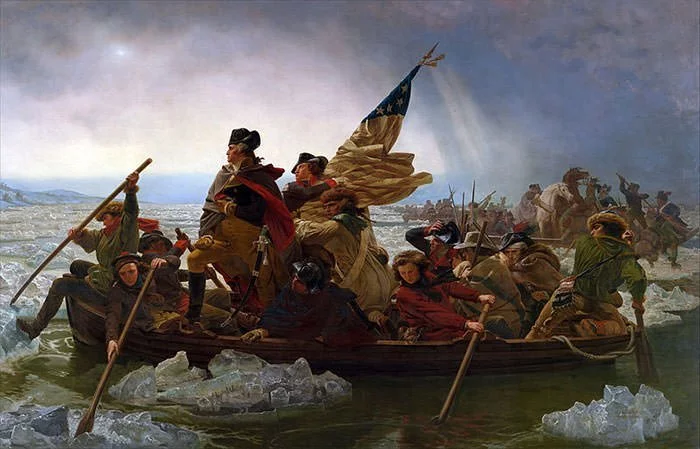
| Location: | Metropolitan Museum of Art, New York City |
| Artist: | Emanuel Leutze |
| Year: | 1851 |
In August 1776, the Americans lost the Battle of Long Island, the first major battle of the American Revolutionary War. After several more defeats, they were forced to retreat through New Jersey and into Pennsylvania. At such a juncture, George Washington, the commander-in-chief of the American troops, made a bold plan to carry out a surprise attack on the enemy forces at Trenton. On the night of December 25–26, 1776, the American forces led by Washington crossed the ice choked Delaware river. The crossing was accomplished “with almost infinite difficulty” with the most prominent danger being the “floating ice in the river”. It was made worse by the arrival of a strong storm that brought freezing rain, snow, and terrifying winds. This important moment in American history, which led to a pivotal victory at the Battle of Trenton, is captured in this painting by German artist Emanuel Leutze. Washington Crossing the Delaware became a sensation and remains one of the most famous paintings in the United States.
#4 The Third of May 1808
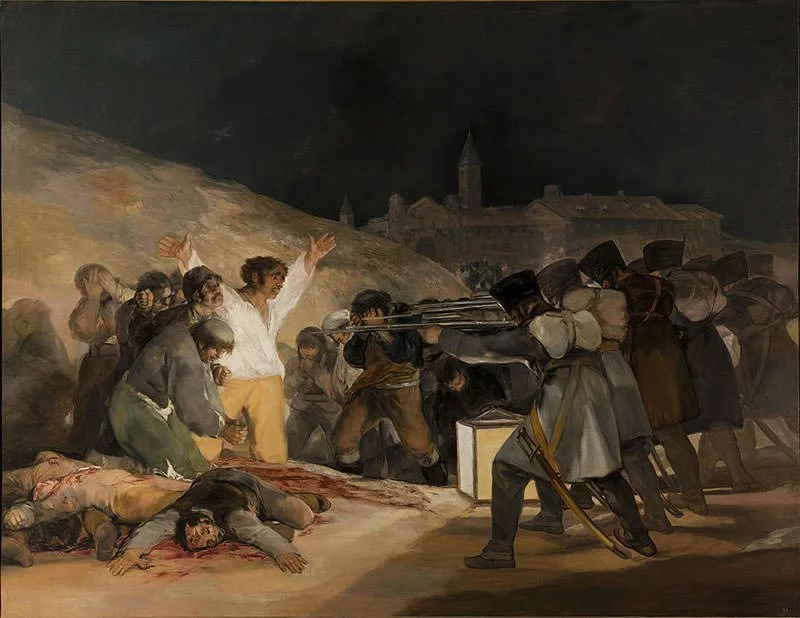
| Location: | Museo Nacional del Prado, Madrid, Spain |
| Artist: | Francisco Goya |
| Year: | 1814 |
On May 2, 1808, the people of Madrid rebelled against the occupation of the city by Napoleon’s French army. Goya has captured this uprising in his painting The Second of May 1808. The Third of May 1808, the most famous painting by the artist, depicts the retaliation by the French the following day, during which hundreds of Spaniards were rounded up and shot. The painting has no distinct precedent as it diverges from the traditional depictions of war. Thus it is considered one of the first paintings of the modern era. Famous British art historian Kenneth Clark called Goya’s masterpiece as “the first great picture which can be called revolutionary in every sense of the word, in style, in subject, and in intention.” The Third of May has inspired several renowned paintings by future artists most prominently Pablo Picasso’s masterpiece Guernica.
#3 The Raft of the Medusa
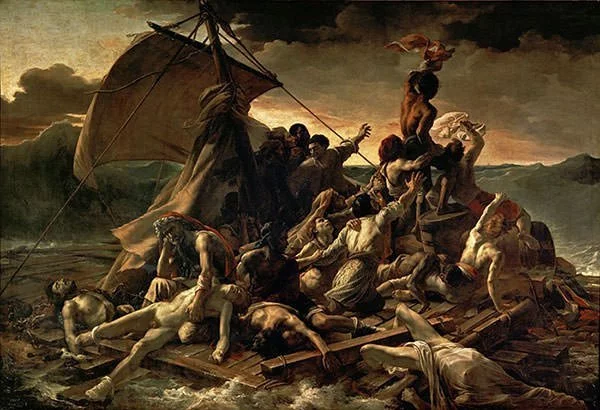
| Location: | The Louvre, Paris |
| Artist: | Théodore Géricault |
| Year: | 1819 |
Méduse was a French warship which fought in the Napoleonic Wars. Though it survived the battles, it crashed in a sandbank in July 1816 while transporting people to Senegal. The 400 people on board had to evacuate; out of which 151 were put on a raft. These men on the raft had to go through a terrible ordeal. Many were washed into the sea by a storm; others rebelled and were killed by officers; the survivors engaged in cannibalism; and when supplies ran low, injured men were thrown into the sea. After 13 days on sea, the raft was found with only 15 men surviving. The event became an international scandal. Théodore Géricault thoroughly studied the incident before creating this masterpiece. The Raft of the Medusa proved to be hugely influential in French art; is considered an iconic work of French Romanticism; and has immortalized the incident it depicts.
#2 Liberty Leading the People
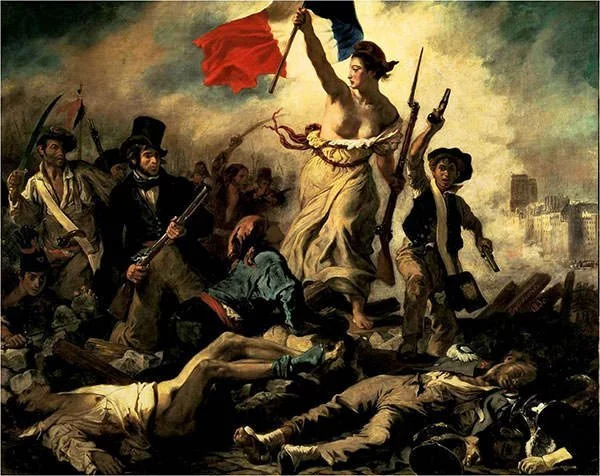
| Location: | The Louvre, Paris |
| Artist: | Eugène Delacroix |
| Year: | 1830 |
Liberty has existed as a goddess in many cultures and during the French Revolution, many allegorical personifications of ‘Liberty’ appeared in France. Since then the figure of Liberty is viewed as a symbol of France and the French Republic. This painting commemorates the July Revolution of 1830 in which King Charles X of France was overthrown. It shows Liberty as both a goddess and a robust woman of the people. She holds the flag of France in one hand and a firearm in her other hand. Liberty Leading the People is a hugely influential artistic work. Among other things, it has been a source of inspiration for the Statue of Liberty and Victor Hugo’s renowned novel Les Misérables. Since its creation, the painting has also served as a republican and anti-monarchist symbol. The masterpiece of the leading French Romantic painter, Liberty Leading the People is among the best known paintings in western art.
#1 Guernica

| Location: | Museo Reina Sofía, Madrid, Spain |
| Artist: | Pablo Picasso |
| Year: | 1937 |
Guernica is a town in northern Spain. On 26th April 1937, during the Spanish Civil War, Guernica was bombed by Nazi German and Fascist Italian warplanes on request of Spanish Nationalists. Picasso created this masterpiece in response to the bombing of Guernica. It brought worldwide attention to the Spanish Civil War and is considered one of the most powerful anti-war paintings in history. There have been numerous interpretations of Guernica since its creation. On the left of the canvas, a wide-eyed bull stands above a woman grieving over a dead child in her arms. The center is dominated by a horse falling in agony as if struck by a weapon. Under the horse is a dismembered soldier while towards its right is a frightened female figure which appears to have floated into the room through a window. From the right, an awe-struck woman staggers towards the center. The two dominant elements in the painting, the bull and the horse, are important characters in Spanish culture. The best known painting of arguably the greatest artist of all time, Guernica is undoubtedly the most famous historical painting.

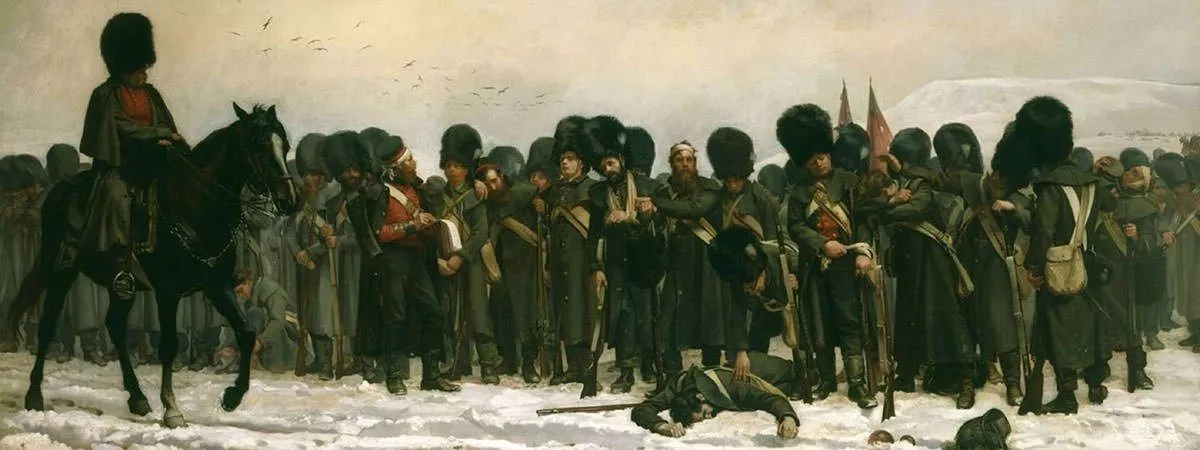
I am Polish guy and we have an incredible painter of such historical paintings, please check Jan Matejko. In my opinion all paintings presented here are second league to any Matejko”s painting.
And this is niot related to the fact that I am Polish. Please check https://www.wikiart.org/en/jan-matejko